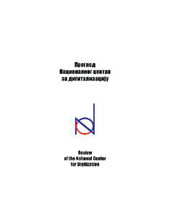Issues
Review of the National Center for Digitization
Publisher: Faculty of Mathematics, University of Belgrade
ISSN: 1820-0109
Issue: 46
Year: 2025

SPATIAL DETERMINANTS OF THE "CIRCLE OF TWO" IN BELGRADE
Zoran Cvetković
Keywords: Belgrade, tramways, "Circle of Two", spatial determinants, urban culture
Abstract
The "Circle of Two" in Belgrade is an area of the city defined by the circular route of the tram No. 2. This space, enriched with commercial, cultural, historical, political, and geographical elements, promotes the informal centre of Belgrade. Long-term urban planning is a complex process that necessitates the involvement of multidisciplinary teams, including urban planners, architects, sociologists, energy specialists, traffic engineers, ecologists, and others. Straying from validated plans or implementing ad hoc solutions regardless of the initiator can result in the disintegration, degradation, and disorientation of urban spaces.This paper does not focus on the aspects related to the aforementioned qualified specialists. Considering the significant current and anticipated changes in both the narrow and broader centre of Belgrade, the primary aim of this paper is to document today's spatial determinants along the line of the "Circle of Two".
1 – 23
ENDOWMENTS AND BENEFACTORS OF SMEDEREVO IN THE 19TH CENTURY
Snežana Cvetković
Keywords: Smederevo, endowments, benefactors, testament, Old Cemetery, modernization
Abstract
In the second half of the 19th century, Smederevo underwent significant modernization processes, which were reflected through intensive economic and industrial development and a flourishing of trade and construction. In the middle of the century, the Church of Saint George the Great Martyr was erected in the city centre. So far, between 1883 and 1888, shortly after the proclamation of Serbia as a kingdom, King Milan's Wharf was built on the Danube, along with the Smederevo – Velika Plana railway line, and the District Administration and Court building designed by the royal architect Aleksandar Bugarski. In 1865, on the estate of his ancestors in the vineyards of Smederevo, Prince Mihailo Obrenović commissioned the construction of a summer residence that would, until 1903, serve as a prominent centre of the city′s social and cultural life. The economic and cultural life of the city was elevated to a higher level - through steam-powered production and the cultivation of grapevines, as well as the establishment of primary, craft and workers’ schools, a gymnasium, women’s emancipation associations, music and sports societies. Alongside this dynamic development, the practice of endowment giving flourished, eventually becoming regulated by law. The foundation for this paper consists of the books "Testaments of the Benefactors of the Municipality of Smederevo" (1927) and "For Those Who Will Come into the World after Us: Endowments and Benefactors in the Archives of Serbia" (2015). An integral part of this work is a critical review of the current condition of endowments and the graves of their founders at the Old Smederevo Cemetery, reflecting a broader issue of collective neglect.
24 – 34
SNOW PERIOD IN BELGRADE
Nedeljko Todorović
Keywords: snowfall and snowcover, middle dates, trends
Abstract
Snowfall and snow cover are characteristic of the cold part of the year in Serbia. They occur most often in the three winter months (December, January, March), and there are smaller or larger deviations so that they are recorded in the autumn and spring months. Extremely rarely, in some places in Serbia, an extreme case of no snow cover has occurred. In Belgrade, this "miracle" has not yet been recorded in the analyzed period from winter 1921/22 to winter 2024/25. There are data on snow since 1887, when measurements and observations began at the Meteorological Observatory in Belgrade, but data before 1921 were not available for this analysis. Data on the height and number of days with snow cover were analyzed from winter 1986/87 to 2024/25. An analysis of the average date of the first and last snowfalls and snow cover with trends in changes was conducted. The study aims to determine whether there were significant changes in snow parameters. The analyzed data and results are presented in tables and graphs.
35 – 40
CLASSIFICATION OF COMPUTER LANGUAGES USED FOR DIGITALIZATION
Dušan Tošić
Keywords: classification, computer languages, digitalization.
Abstract
The paper proposes a classification that includes all computer languages. The connection of each class with digitalization was considered. Thus, we can distinguish two large classes: Programming Languages and Domain Specific Language (DSLs). In the first class, two subclasses: low-level languages and high-level languages are further distinguished. Since high-level languages are the most numerous, we paid special attention and classify them into classes based on the dominant programming paradigm that they support. In the DSLs class (which contains a large number of diverse languages), we singled out markup and query languages because of their prevalence and importance for digitalization. The third subclass, within DSLs, consists of all other DSLs.
41 – 46
RANKING RESEARCHERS IN UNIVERSITY OF SZEGED 2025
Gyula Mester
Keywords: ARWU – Academic Ranking of World University, citations, h-index, Google Scholar, Orcid ID, ranking researchers in University of Szeged 2025.
Abstract
The paper presents the ranking researchers in University of Szeged 2025. In the ARWU 2024 - Academic Ranking of World University 2024 - ranks the University of Szeged as the highest ranked (401-500) university in Hungary. The ranking is presented primarily according to the researchers’ hindex. Researchers with matching h-index are ranked by the number of citations. The minimum h-index of the 15 ranked researchers is 50. The h-index can be determined from the following online databases: Web of Science, Scopus, Google Scholar and the Publish or Perish program. The h-index, also known as the Hirsch index, is based on references. The ranking will be edited using the Google Scholar web database. Google Scholar is Google's scientific search engine, launched in 2004. We also present the Orcid ID number of the researchers.
47 – 52